When I started to realize I’d been fed a diet of lies, I began trying to pick things apart and re-assess most of what I had ingested. Howard Zinn was a huge help, for me, not because I think he’s right about everything, but because he offers a different perspective on established history. We’re left to our own devices with so much, otherwise – the “is this racist?” or “is this offensive?” conversation – it has to happen as an inevitable consequence of re-assessing the constructed history of a time. I’ve had discussions about this in some strange places, about some strange times; probably my favorite was “why isn’t there a lot of Vietnam War reenactment?” (My answer to that: “because bombers are too expensive to reenact.”)
I like to steer away from the “is this offensive?” discussion because it involves other people’s feelings, and it’s easy for someone to game me by asserting they feel something that I have no way of knowing if they feel or not. That’s where we get the lamentable argument, “well, it doesn’t offend me so I’m going to keep using it!” or worse, “I asked a real ${whatever} and they said it was OK.” Let’s not even get started on the “Well, ${whatever} call each other that, so – Free Speech!” angle. My approach is that I recognize that someone may or may not be offended by anything and so I ignore that and look instead at whether the representation is fair, or accurate.
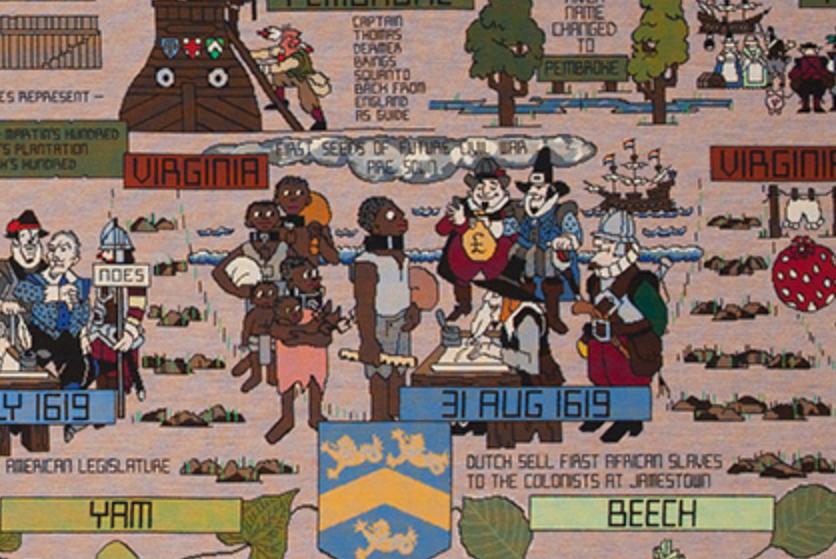 Let me give an extreme example, because that sets the bar at one end of the discussion where it’s not very nuanced: let’s say I’m looking at a photograph of a nazi concentration camp, including starving victims. Is the representation of the victims inappropriate? Well, as long as it’s historically accurate (i.e.: they aren’t smiling) then what I’m looking at is a representation of nazi horribleness and if there’s something in there that offends me it’s the horribleness of the nazis, not the plight of the victims. I don’t think I am being disrespectful of the victims (or the nazis) – again, assuming it’s a fairly accurate illustration of historical reality. If there’s offense to be had at the image, it’s at the actions of the nazis. If the image included some reality TV star giving one of the victims a no-calorie Pepsi, and the victims were all smiling and dancing afterward, then it would be an illustration of how horrible Pepsi’s marketing is, and so forth. To me, this all revolves around how the people are represented in their historical context and whether it’s accurate.
Let me give an extreme example, because that sets the bar at one end of the discussion where it’s not very nuanced: let’s say I’m looking at a photograph of a nazi concentration camp, including starving victims. Is the representation of the victims inappropriate? Well, as long as it’s historically accurate (i.e.: they aren’t smiling) then what I’m looking at is a representation of nazi horribleness and if there’s something in there that offends me it’s the horribleness of the nazis, not the plight of the victims. I don’t think I am being disrespectful of the victims (or the nazis) – again, assuming it’s a fairly accurate illustration of historical reality. If there’s offense to be had at the image, it’s at the actions of the nazis. If the image included some reality TV star giving one of the victims a no-calorie Pepsi, and the victims were all smiling and dancing afterward, then it would be an illustration of how horrible Pepsi’s marketing is, and so forth. To me, this all revolves around how the people are represented in their historical context and whether it’s accurate.
So, to business: the question comes up whether the New World Tapestry [nwt] is problematic. [bbc]:
A British tapestry depicting Native Americans as “subhuman, warlike savages” should not be put on public show, campaigners say.
The 267ft (81m) New World Tapestry perpetuates a “racist tradition”, the National Congress of American Indians (NCAI) said.
But designer Tom Mor said the claims were “rubbish”.
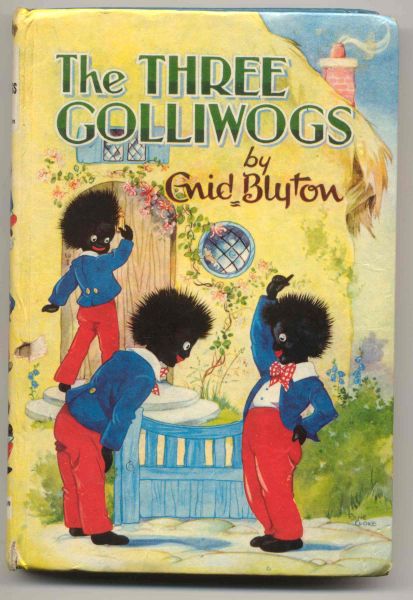 Here’s the problem: the times when white people appear in the tapestry, unless something embarrassing or violent is happening to them, they are portrayed with little dot-eyes. And every time black people or indigenous people are represented, they are portrayed with great big white golliwog eyes. You may not be familiar with the term “golliwog” and, if you’re not, it’s my unfortunate duty to explain it to you: A “wog”,[wikipedia] you may or may not know, is an imperialist british term for anyone who was not a white English person.
Here’s the problem: the times when white people appear in the tapestry, unless something embarrassing or violent is happening to them, they are portrayed with little dot-eyes. And every time black people or indigenous people are represented, they are portrayed with great big white golliwog eyes. You may not be familiar with the term “golliwog” and, if you’re not, it’s my unfortunate duty to explain it to you: A “wog”,[wikipedia] you may or may not know, is an imperialist british term for anyone who was not a white English person.
The saying, “The wogs begin at Calais” (implying that everyone who is not British is a wog), appears to date from the First World War but was popularised by George Wigg, LabourMP for Dudley, in 1949 when in a parliamentary debate concerning the Burmese, Wigg shouted at the Conservative benches, “The Honourable Gentleman and his friends think they are all ‘wogs’. Indeed, the Right Honourable Member for Woodford [i.e., Winston Churchill] thinks that the ‘wogs’ begin at Calais.”
As reported by English-Jewish journalist Linda Grant, people in England have referred to Jews and Israelis as “wogs”, as well.
Oh, Haw-haw, those British imperialists, what a witty bunch of oligarchs they were, what what? When I was a kid, Enid Blyton was still a thing; I read some of her stuff; I remember most Island of Adventure but my parents never gave me The Three Golliwogs.
The New World Tapestry’s rendering of black people – especially chattel slaves (because, that’s the only kind of black people in the tapestry) is not quite golliwog but it’s pretty damn close. The NCAI said the tapestry is perpetuating a racist tradition. It’s actually perpetuating several racist traditions.
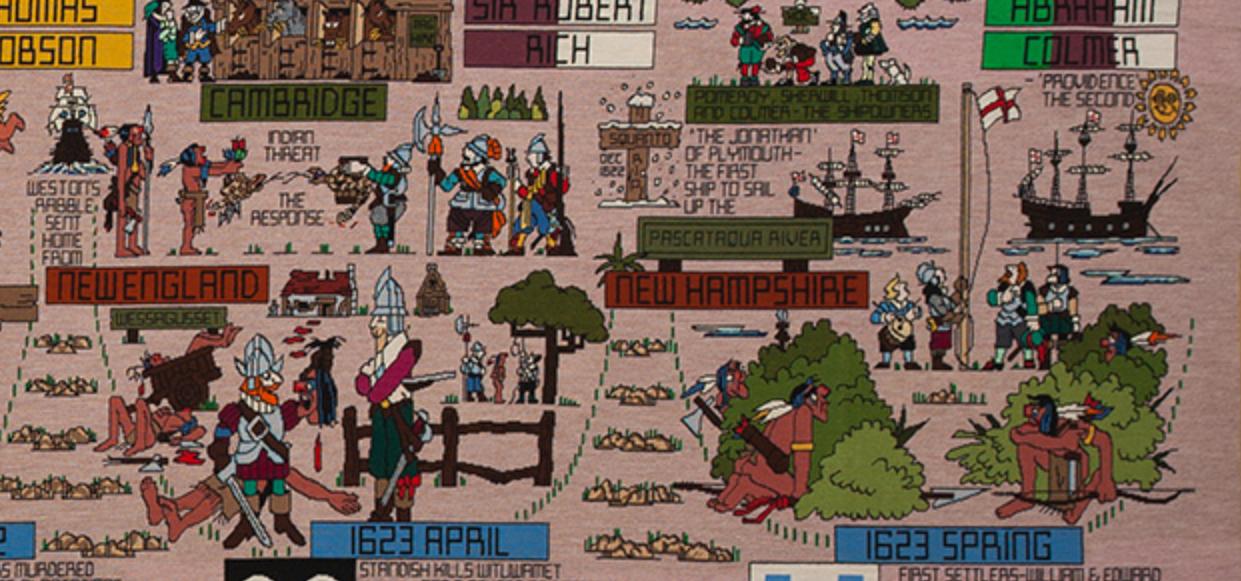 It’s easy to say that the tapestry is trying to represent a kind of historical accuracy, and that therefore it’s OK, blah, blah, blah – but it’s not historically accurate that black people walked around with their eyes bugged out; they are represented as racialized caricatures. The native americans are represented as racialized caricatures, as well; they have great big square beak-noses and big white eyes and they’ve got a nasty case of spray-tan. The incidents represented are the Narraganset war, in which the native americans threatened the colonists in Plymouth by sending them a bundle of arrows. The colonists responded with a bundle of bullets, which delayed open warfare for a year or two, but eventually the colonists decided to strike first and murdered the leader of the Narraganset, Wittamut, in a surprise attack – they were parleying and Standish disarmed him, then cut his head off, as is shown in the tapestry. The bodies of native americans are strewn about in that frame, and one appears to be about to be hanged.
It’s easy to say that the tapestry is trying to represent a kind of historical accuracy, and that therefore it’s OK, blah, blah, blah – but it’s not historically accurate that black people walked around with their eyes bugged out; they are represented as racialized caricatures. The native americans are represented as racialized caricatures, as well; they have great big square beak-noses and big white eyes and they’ve got a nasty case of spray-tan. The incidents represented are the Narraganset war, in which the native americans threatened the colonists in Plymouth by sending them a bundle of arrows. The colonists responded with a bundle of bullets, which delayed open warfare for a year or two, but eventually the colonists decided to strike first and murdered the leader of the Narraganset, Wittamut, in a surprise attack – they were parleying and Standish disarmed him, then cut his head off, as is shown in the tapestry. The bodies of native americans are strewn about in that frame, and one appears to be about to be hanged.
A child who sees this might come up with some distorted ideas about the history of the times, and of native americans. Portraying black people and native americans as the tapestry does, it is, in fact, supporting white supremacy. Yes, white supremacy is a historical phenomenon – it really did happen. But the tapestry is only presenting the winner’s perspective. Artists can’t help but take sides when they’re creating a representation of a historical event.
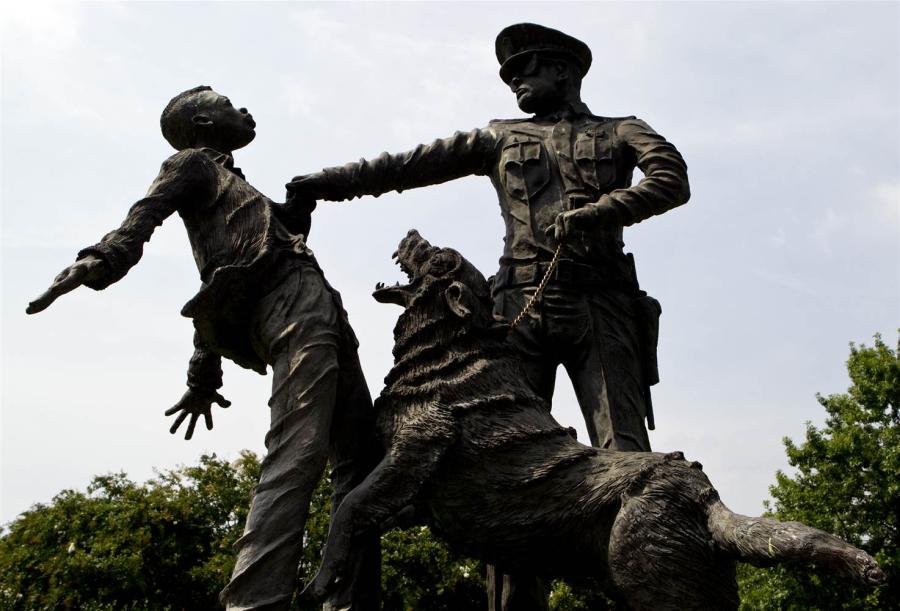
“The Footsoldier” by Ron McDowell
Malcolm Gladwell does a piece in which he interviewed the artist who made “The Footsoldier” statute that’s in Ingram Park. One of the things I thought was interesting was when Gladwell tried to (in his dweebly way) nudge McDowell about how he changed the representation of the dog and the cop: the dog has been turned into a huge, ferocious, wolf-like thing, the cop is built like an aryan superman – and McDowell’s reply to Gladwell is spot on, in my opinion: [medium]
RM: Well, I saw that the boy was being about 6’4, the officer was maybe 5’10, 5’9. And I said, “This is a movement about power.” So I made the little boy younger and smaller, and the officer taller and stronger. The arm of the law is so strong, that’s why his arm is almost, like, straight. And the dog is more like a wolf than a real dog. Because if I’m a little boy, that’s what I would see. I would see like this superman hovering over me, putting this big old giant monster of a dog in my groin area, in my private area. And so, that’s what I envisioned when I first saw the photograph.
MG: And you changed it. In the photograph I noticed the boy is leaning in and in your sculpture, he’s leaning back. Tell me about that.
RM: He’s leaning back because I wanted to depict him showing that, “I’m not going to fight you, I’m not leaving, I’m not moving, I’m standing, but I’m not gonna fight you. This is a non-violent protest.” That’s why his hands are open and he’s going back, like, “Do whatever you’re gonna do. Put the dog on me, beat me with the club, whatever you wanna do.” And I saw all of that when I saw the photograph.
McDowell is getting at the issue: he’s representing an event, he’s not recording it. He’s interpreting it, but he’s interpreting it in such a way that you should take sides when you see it. I’m sure there are some people who see that statue and fancy themselves as the cop. There are plenty of garbage humans out who worship authority. McDowell amplifies the power dynamic of the situation so that it’s more clear what’s going on. It’s the same thing as Schindler’s List – Spielberg is not subtle in his portrayal of Amon Goeth as a horrible garbage human; we’re supposed to take sides. Yet it’s mostly historically accurate. The cop in McDowell’s statue is not portrayed as a fat, sweaty, balding stereotypical southern white pig-cop with a bag of donuts: he is perhaps a caricature of authority, as the dog is a caricature of a police dog.
Tom Mor’s representation of black people and native americans in the tapestry relies on racialized caricatures, and also presents a sanitized version of racist genocide. How do I say it’s “sanitized”? For example, look at the exchange between Standish and the native americans: they threatened the colonists, Standish replied with a threat, and then.. there was a massacre. Mor elides the historical context of what was going on at the time, making it seem as though the native americans just threatened Plymouth colony because, reasons. Obviously, it would be impossible to represent all the treaties, alliances, raids, and massacres that took place surrounding that incident, but by choosing what he chose, Mor is selectively focusing on parts that make the colonists look better. It’d be as though Spielberg only had Amon Goeth appear in Schindler’s List as a detached bureaucrat who just sat in his office while the death-camp hummed around him. Spielberg was careful to represent Goeth fairly thoroughly.
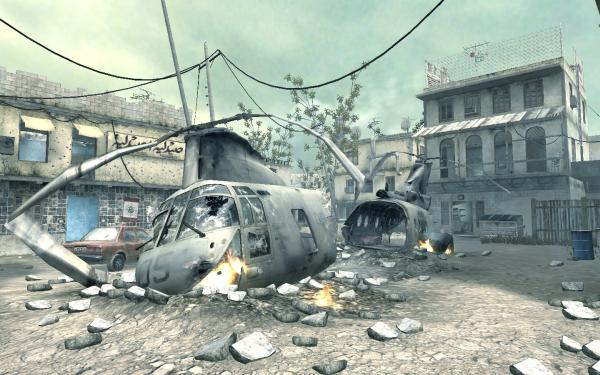
Call of Duty map; this is a recreation of the downed helicopter in Mogadishu. Teach your kids to kill black people!
Let’s not talk about Tom Mor’s tapestry any more; I don’t think it’s worth it.
Why is this stuff important? It’s important because this subtle propaganda is absorbed as if through our skin. It’s absorbed through television, games, books – all of popular culture. And it matters: I was watching some kid at Best Buy playing some first-person shooter like Call of Duty and he was running through a street that looked like someplace in Syria, shooting at caricatured “jihadis” that were a) brown b) didn’t fight back very effectively c) yelled “allahu akbar” when they died. That kid will be easier to form into a soldier of the empire, at least up until the moment when he kills his first victim and realizes that we all bleed and scream more or less the same.
This has been a serious problem for me; I grew up in Baltimore (a racially segregated city, at the time) and most of what I knew about black people was from reading Tintin comics. A few years ago, I asked my parents to bring one of the old volumes back when they returned one summer – because it’s gotten hard to find, anymore. This is how I learned about black people:
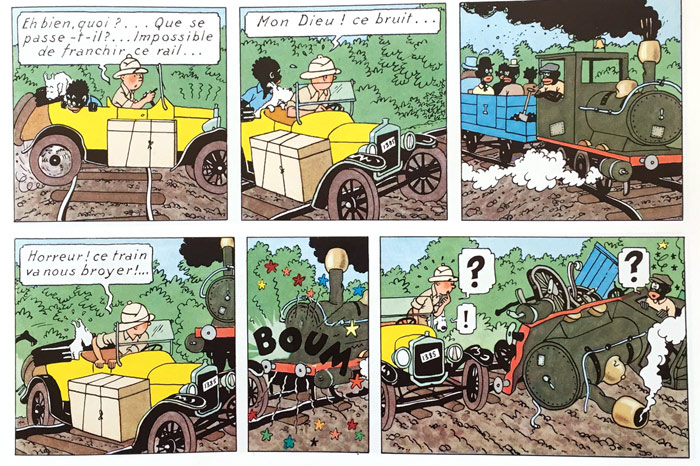
Tintin gets stuck on the train tracks (because: not very bright) and a train comes. It hits the white man’s car and the train is destroyed. Hahahaha. What a garbage quality train!
The caricature at play here is: Africa sucks; it’s backwards and low-tech. I was a kid when I read this, remember. I did not know about Songo Mnara yet. This is where I started learning about Africa.
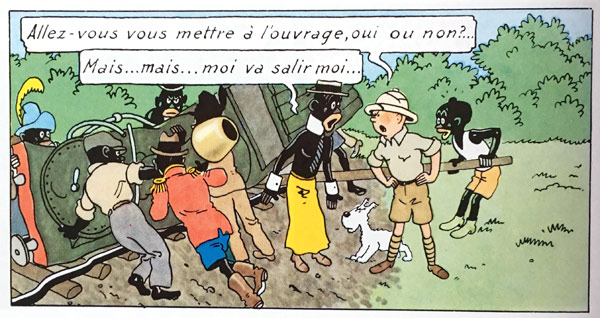
Oh, look at all the caricatures here: there’s a “fancy” black guy who doesn’t want to work, who speaks broken French (“Myself I will dirty myself!”) and the white guy is yelling at him while everyone else is working including the “fancy” guy’s wife (in the big blue hat) and the tinpot military man (with epaulettes) – it’s cringe-worthy as hell, but I didn’t know until much later. I had to dig this crap out of my brain before I could even begin to make a sensible approach to the colonial history of Africa. And, only after I had done that could I dig below that and learn about the rich and interesting civilizations that existed before the white people and their guns showed up. I can trace my re-awakening to the movies Zulu and Zulu Dawn and to George MacDonald Fraser’s Flashman and the Tiger.
It took until I was in my 30s, and the devil was dancing in Rwanda, that I decided to really study colonialism, and I discovered that the author of Tintin, Georges Remi, was Belgian and Belgian colonialism was the root cause of that whole mess; there’s a direct connection, in my mind, between the kind of casual stereotyping and racism in Tintin, and the more serious stereotyping we see all the time in America, with white supremacists strutting around thinking they are superior. If one grew up only absorbing these sorts of stereotypes and caricatures, I can see how it’d be pretty easy to think, if you looked like skinny little white/blonde Tintin, that you were somehow superior. Especially because everyone else is portrayed as inferior and slightly clownish.
I’m OK with putting this sort of stuff on display. But it needs the context to go with it. Is there a Museum of Crap Art? The tapestry’d be at home in the front hall.

“I recognize that someone may or may not be offended by anything and so I ignore that” – … is probably the sound of me failing a Privilege Check.
I refer to stereotyping as “wrong” in the sense of “incorrect” not in a moral sense. It’s wrong because stereotypes are always inaccurate; they’re a form of reified confirmation biases and all they say is that the stereotyper is a sloppy thinker.
By the way, Tintin was pretty horrible about: sailors (they’re all drunks) jewish professors (they’re all out to lunch eggheads) arabs (they’re subhuman) chinese (sneaky and literally slant-eyed) etc. It goes on and on. Do I think Tintin should be banned? Emphatically no. Is it good art? Emphatically no, again. Parents exposing their kids to this sort of crap should warn and educate them, or they’ll have to spend decades rooting the garbage out of their subconscious.
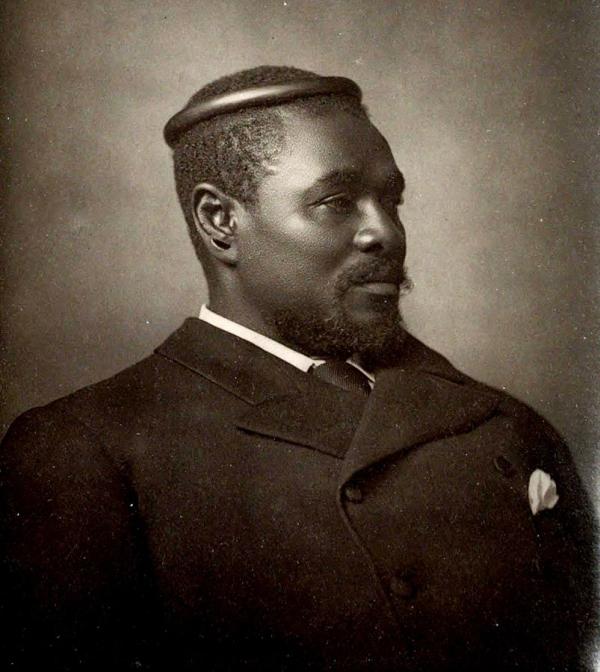
Cetshwayo, nephew of Shaka, king of the Zulu
A word about Zulu and Zulu Dawn, if I may. What portrays a pair of horrific massacres as interesting? Well, the defense of Rorke’s Drift was an impressive feat of arms, as was the Zulu’s willingness to keep attacking the place. It was typical military glory: stupid and bloody and nasty. But that’s how military glory is. Zulu Dawn was interesting – at first I thought that they were caricaturing what a bunch of incompetent dipsticks the british military aristocracy was – so I did more research and found out that the british military aristocracy was actually represented generously. They were incredibly bad leaders, horrible strategists, and deplorable tacticians. That’s why Chard and Bromhead (Rorke’s Drift) came out looking so good: they managed not to get slaughtered. That was quite an accomplishment. I was interested in Ceteswayo after reading about Isandlwhana in Flashman (GMDF also portrays the British military aristocracy as a bunch of dumbasses) and all I can say is that Ceteswayo is what the British aristocrats wished they were. Isn’t that an amazing portrait?! And his iron crown is The Badassness.

Thank you for this, Marcus.
Is there a Museum of Crap Art?
Well, this one is specialized to one area, but yes:
https://ferris.edu/jimcrow/
mikey@#3:
Is there a Museum of Crap Art?
I’m not aware of one. There are some museums that specialize in subgenres that strike me as pretty much crap, though that’s a matter of my opinion. Part of the fascinating thing about art is that the artist seldom produces it going “this is crap.” So there’s always a disagreement about the crapulousness of some artwork or other.
As designer Tom Mor says, the complaints are “rubbish” – but maybe he’s not seeing the rubbish for the scrapheap.
cartomancer@#1:
I’ve never seen that before; making a mental note to try to find someplace where all the Mitchell and Webb is located so I can mine that motherlode. Those guys are really great, and that clip is the perfect commentary on this topic (it’s as if people have had to visit it again and again or something!)
Caine@#2:
Oh, I should have probably gone into Tintin’s coverage of Indigenous Americans… No, probably not; you’ve seen it all before. It’s basically racist/imperialist crap like the tapestry.
It astounds me that Robertson’s the jam maker used a Golliwog as a brand marker until 2002! https://en.wikipedia.org/wiki/Robertson%27s
It’s somewhat fitting (if that is the correct word?) that Golly was replaced by characters from Roald Dahl: http://lithub.com/when-roald-dahls-editor-decided-he-was-too-much-of-a-prick-to-publish/
Marcus Ranum @ # 4: … the crapulousness of some artwork or other.
[ahem!] crapulous: adjective – 1. given to or characterized by gross excess in drinking or eating. 2. suffering from or due to such excess.
Btw, since all those, ah, transcalaisians have received so much representation, surely they owe some taxation…
I like to steer away from the “is this offensive?” discussion because it involves other people’s feelings, and it’s easy for someone to game me by asserting they feel something that I have no way of knowing if they feel or not.
When somebody tells me that they feel/don’t feel offended, I assume that they are probably telling the truth. What’s the point of lying about one’s emotional state anyway? The problem is that each person is offended by different things. For example, the best way how to offend/insult me would be to say that I’m feminine/girlish/ladylike. That would offend me, but this certainly doesn’t offend most other people. In fact, many women and trans women like being seen as feminine. Thus “never call anybody ‘feminine’” is a bad rule. When a significant amount of people tend to get offended by something, then it’s generally a good rule to never do/say that. For example, “never use the word ‘nigger’” is a good rule. If one uses the word, some people will get offended while others won’t. If one does not use the word, nobody will get offended. Other than that I just follow whatever each person tells me. If a friend tells me that they don’t like something, then I don’t do that in their presence.
That’s where we get the lamentable argument, “well, it doesn’t offend me so I’m going to keep using it!” or worse, “I asked a real ${whatever} and they said it was OK.”
This is silly. It’s normal for something to offend some people but not others. I don’t think there can be something inherently offensive about an artwork or a word. It’s just paint on paper or sounds made by human tongue. It becomes offensive only when human eyes or ears perceive it. Whether the particular person will experience negative emotions (aka “get offended”) or not depends on their cultural background, individual circumstances, prior experiences, prior beliefs, and context. And all that is different for each person. For example, some people find nudity offensive, others do not. It’s pointless to argue whether nudity itself is offensive or not. It’s neither. There are only subjective human experiences and emotions; there are people who either experience or do not experience the sensation of getting offended when they see it.
Let’s not even get started on the “Well, ${whatever} call each other that, so – Free Speech!” angle.
I’m fine with free speech. Anybody is free to call me feminine or throw at me whatever insults they can think of. Of course, they should also be prepared to face the consequences, namely, I’m not going to be friendly afterwards.
My approach is that I recognize that someone may or may not be offended by anything and so I ignore that and look instead at whether the representation is fair, or accurate.
That’s reasonable. It’s definitely better than “this artwork offended 55% of ${whatever} and it didn’t offend 45% of ${whatever}, therefore this artwork is bad and shouldn’t be displayed”.
To me, this all revolves around how the people are represented in their historical context and whether it’s accurate.
I also look at whether I like the group or not. For example, I often intentionally offend/annoy Christians and nationalists. An artwork/cartoon/joke mocking Christians might be unfair and inaccurate (it stereotypically displays them as worse than they really were), but, since I don’t like Christians, I’m willing to mock and offend them anyway. I could try to sound more objective and claim that I look at whether the group deserves compassion/sympathy or not, but that would be deluding myself. It really boils down to personal likes/dislikes.
This has been a serious problem for me; I grew up in Baltimore (a racially segregated city, at the time) and most of what I knew about black people was from reading Tintin comics.
Yep, I had a similar problem. It wasn’t about black people that much though. Growing up I learned about Russians, gays, transpeople, Muslims etc. from media, which were portraying harmful and inaccurate caricatures.
I had to dig this crap out of my brain before I could even begin to make a sensible approach to the colonial history of Africa.
Yes, same for me once again. Somewhat. My problems were with all that Russians, Muslims and LGBTQ crap planted in my brain. I never encountered that many negative portrayals of Africans or Native Americans. My school history textbooks portrayed colonization of America as a genocide against Native Americans. I also remember sections about the horrors of slavery and discrimination. So I actually grew up seeing Englishmen and Americans as cruel assholes.